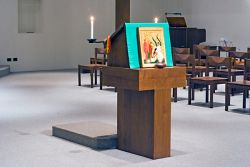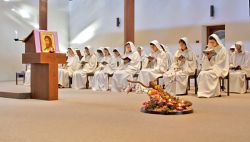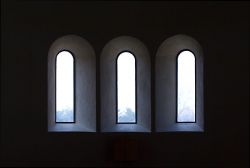Presentation of the Bose Psalter
Warning: Invalid argument supplied for foreach() in /home/monast59/public_html/templates/yoo_moustache/styles/bose-home/layouts/article.php on line 44
d) The reading of Sacred Scripture
The Book of daily prayer gives two readings, one from the Old Testament and one from the Gospel, in the morning and a reading of the Epistle in the evening.
The Bible, distributed according to the weekday lectionary of Bose, is thus read almost in its entirety: the Old Testament in a cycle of three years (A, B, and C), the New Testament (Gospel and Epistle) in its entirety in the course of one year. Only those passages of the Old Testament are omitted which with difficulty can be the object of a lectio divina or provide enough daily food to nourish the faith.
The choice of books seeks both to respect the economy of liturgical seasons and to obey the principle of continuity. We believe that the weekday lectionary presented here, the fruit of years of work and experimentation, can help the Christian do the lectio divina daily, reading practically all the Scripture without great jumps.
The Sunday lectionary is that of the Catholic Church, a lectionary that on account of its spiritual intelligence has been adopted as well by some Reformed Churches. Nevertheless, we have wanted to suggest some further texts, which we always write in italics and mark with an asterisk, to provide Old Testament parallels that fit the Gospel better and to include also the second reading (Epistle) in the parallel lectio. The texts in italics and marked with an asterisk, hence, are to be viewed as suggestions of our community should the lectionary be revised.
e) Responses
Between the readings of the Old Testament and the Gospel stand responses, which have the function of answering with praise the proclamation of the Word. These consist of an Old Testament text, the singing of which by a soloist is broken up by an antiphon from the New Testament sung by all, which interprets the text most often Christologically, sometimes eschatologically or ecclesiologically. The responses in this way arrange in unity the Old and the New Testament and at the same time indicate the liturgical period in which the Scripture reading takes place.
The evening responses, shorter than those in the morning, are always executed alternately by soloist and assembly, which picks up a part of the text sung by the soloist, and correspond to the reading of the Epistle. Almost always the text is drawn from the monastic Thesaurus.
f) Silence
Silence is an essential element of the liturgy (cf. SC 30)! Its function is to aid meditation of the Scriptures, hence should not be too short. It should allow the Word of God to be fixed in mind and heart so that it may be retained and meditated through the following hours.


